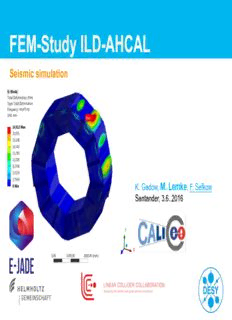
FEM-Study ILD-AHCAL PDF
Preview FEM-Study ILD-AHCAL
FEM-Study ILD-AHCAL Seismic simulation K. Gadow, M. Lemke, F. Sefkow Santander, 3.6..2016 Overview > Reminder of earlier studies > Sub-structuring method > First results > Outlook Martin Lemke | FEM-Study ILD-AHCAL | 11. 03. 2016| Seite 2 AHCAL submodule case 2 submodule installation installation of submodules in front of the cryostat by crane sub module connection by plates from the front and back side Martin Lemke | FEM-Study ILD-AHCAL | 11. 03. 2016| Seite 3 Earlier studies > Static calculations of absorber structure deformation and stress § Including configurations during assembly § Design validated > Data from 2011 earthquake pre- processed for dynamical analysis > First step: modal analysis: determine eigen modes and frequencies of system > Combination of large dimensions and small details very challenging § Full model impractical, slow convergence § For the study of the complete configuration a different approach is needed Martin Lemke | FEM-Study ILD-AHCAL | 11. 03. 2016| Seite 4 AHCAL Mechanics absorber structure validation (static) • ~360 N/mm² maximum tension • 50 times exaltation graphic Martin Lemke | FEM-Study ILD-AHCAL | 11. 03. 2016| Seite 5 Data preparation for Response Spectrum Analysis > NIED-Software Tool „Strong Motion Data Analysis used to prepare data > Tool to generate power spectrum as input for response spectrum Analysis > Data extraction via screenshot and Open Source Tool „Get Data Graph Digitizer“ and export to Excel Martin Lemke | FEM-Study ILD-AHCAL | 11. 03. 2016| Seite 6 Modal analysis: Eigen modes > Swinging barrel: 3Hz > Swinging module: 8Hz > Swinging plate: 6Hz > Higher modes: 15 Hz > Several plates: 45 Hz Martin Lemke | FEM-Study ILD-AHCAL | 11. 03. 2016| Seite 7 Appropiate calculation method for complex structures > First tests with a substitution method for the complex AHCAL-Segments with effective material parameters (effective elastic modules and sheer modules, as well as effective Poisson's ratio) in combination with a homogeneous body as a replacement for the detailed AHCAL-Segment => unfortunately no real breakthrough > Another way to calculate such a complex model like the AHCAL- Structure had to be found … > The chosen calculation method is the Substructuring Method and hereby especially the Component Mode Synthesis (CMS) as a form of substructure coupling analysis in ANSYS used in structural dynamics > Built up test cases in ANSYS to develop the APDL-Command-Snippets (handling geometry/model, combine result-files) Martin Lemke | FEM-Study ILD-AHCAL | 11. 03. 2016| Seite 8 Substructuring – A short explanation > Substructuring is a procedure that condenses a group of finite elements into one element represented as a matrix. The single-matrix element is called a superelement. (Source: ANSYS Help V17.0) > Three steps to use this method: § Generation Pass to calculate the superelement matrices (mass, stiffness, damping) and to define the Master DOFs § Use Pass to integrate the superelments into the Finite Element Model, the Master DOFs are used to define the boundary conditions (supports, loads, contacts) § Expansion Pass to assign the results of the superlements to the original geometries Martin Lemke | FEM-Study ILD-AHCAL | 11. 03. 2016| Seite 9 Figure-Source: CADFEM GmbH/Germany Scheme for dynamic analysis-run with CMS-Method > Generation Pass only calculated for Build up CMS-Model the first run, with same model, the with Generation generated Superelements (and the and Use Pass corresponding files) can reused in various analysis again Pre- stress MSUP Response Geometry Static Modal View Spectrum Preparation Analysis Analysis Results Analysis Expand Expand Expand Superlement- Superlement- Superlement- Results onto Results onto Results onto origina l origina l origina l Structures Structures Structures Martin Lemke | FEM-Study ILD-AHCAL | 11. 03. 2016| Seite 10
Description: